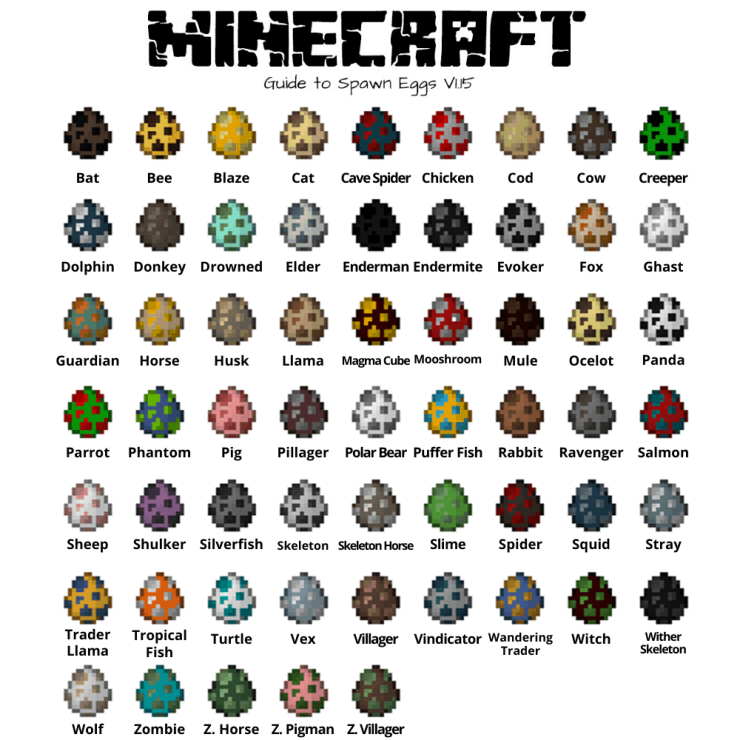A spawn egg is an item used to spawn mobs directly in Minecraft. Spawn eggs are useful for all kinds of activities, but most players use them to create farms, decorate, or experiment with mob behaviors. In this article, we are going to showcase everything you need to know about the Spawn Egg, including how to obtain and use it, updated for Minecraft as of September 2025.
Table of Contents
1. How to get spawn eggs in Minecraft
Spawn eggs are special items that can only be acquired in Creative mode or via commands. They cannot be obtained through normal gameplay in Survival mode. In Creative mode, press the pick block button (middle mouse button by default) on an existing mob to obtain its respective spawn egg. Alternatively, access them directly from the Creative inventory: in Java Edition, they have their own tab, while in Bedrock Edition, they are at the bottom of the Nature tab.

There are currently 82 spawn eggs in Java Edition and 84 in Bedrock Edition, including those for new mobs added since 2021 such as axolotls, glow squids, goats, frogs, tadpoles, allays, camels, sniffers, armadillos, breezes, boggeds, creakings, happy ghasts, and copper golems (some may require experimental toggles).
To give yourself spawn eggs using commands, use the following format: /give @p minecraft:(mob)_spawn_egg [amount]
For example, to get one axolotl spawn egg: /give @p minecraft:axolotl_spawn_egg 1
2. How to use spawn eggs in Minecraft
To use a spawn egg, press the use button (right-click by default) on any block surface (top, bottom, or side). The mob will spawn with its feet adjacent to the surface, and its ambient sound will play. Block surfaces are prioritized for spawning; mobs can even be spawned in water or air if no suitable ground is nearby.
In Java Edition only, you can create baby mobs by using a spawn egg on an adult mob of the same type. For example, using a sheep spawn egg on a sheep spawns a baby sheep with the same wool color.
Spawn eggs can also be used on monster spawners or trial spawners to change the mob they generate. In Bedrock Edition, for fish mobs, the spawner must be waterlogged for the egg to work.

Spawn eggs are particularly useful for obtaining more of certain mobs that cannot be bred naturally, such as parrots (which can be tamed but not bred in vanilla Minecraft) or other non-breedable entities.
Note: Spawn eggs are consumed upon use in Survival mode but not in Creative mode. They can also be fired from dispensers to spawn mobs automatically.
3. Spawn eggs renaming and secrets
Players can rename a spawn egg using an anvil. When used, the spawned mob will display the custom name above its head, visible when aiming at it from four or fewer blocks away. This name also appears in death messages but does not prevent the mob from despawning (use a name tag for that).
Renaming unlocks several Easter eggs:
- Renaming a vindicator spawn egg "Johnny" makes it hostile to all mobs except other illagers.
- Renaming a rabbit spawn egg "Toast" unlocks the secret "Toast" skin for the rabbit.
- Renaming a sheep spawn egg "jeb_" causes the sheep to cycle through rainbow wool colors (dropped wool remains original color).
- Renaming any spawn egg "Dinnerbone" or "Grumm" makes the mob appear upside down, with the name displayed above it.

4. New tricks and advanced uses in 2025
With recent updates through Minecraft 1.21.9 (as of September 2025), spawn eggs have seen enhancements, including texture updates where eggs are sized as "Small," "Medium," or "Large" based on the mob (revertible with the Programmer Art resource pack).
Automation with Dispensers: Place spawn eggs in dispensers connected to redstone circuits for automated mob spawning, ideal for farms or traps. For example, dispense eggs onto spawners to dynamically change mob types.
Experimental Mobs: Enable experimental features to access spawn eggs for new mobs like copper golems or creakings, which can be used in custom maps or testing new mechanics like breeze wind charges or bogged poison arrows.
Edition-Specific Tricks: In Bedrock Edition, spawned wandering traders always come with two leashed trader llamas, and villagers spawn with randomized professions. Use this for quick trading halls. In Java Edition, leverage baby spawning for efficient animal farms.
Trial Spawners: Apply spawn eggs to trial spawners (introduced in 1.21) to customize challenge rooms in trial chambers, spawning mobs like breezes or boggeds for unique combat scenarios.
>>> Read more: How To Get ALL Minecraft Cats And What They Do










Comments